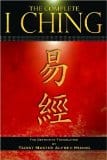
The Complete I Ching: The Definitive Translation
, by Master Alfred Huang
Inner Traditions, 502 pp. (+ glossary & index), 1998, 2004
I Ching is a system of guidance (I wouldn’t call it divination, even though many do), and I definitely wouldn’t refer to it as fortune telling) which I first encountered over 30 years ago. At the time, it was one of the “divination” systems that was gaining in popularity. I found it not to be my style, so I put it aside. I learned Tarot, a bit of astrology, some rune lore, and a variety of other systems.
Imagine my surprise when this book appeared (unasked for) in a shipment of books for review. It seemed as if I was fated to re-explore this system. Having added three decades of life experience opened me to some of the subtler meanings of the trigrams (3-line portions of the total figure) and hexagrams (complete 6-line figures).
The author himself refers to it as a book of divination, but I feel his (Chinese) perception of divination is far removed from that of the average Westerner. He sees it as divine guidance, whereas most Westerners see it as predictions, thus my reluctance to use the word “divination”.
This translation, from a Taoist Master, is the most extensive treatment of the subject I have ever encountered. I have a couple of other translations in my library, but they lack the depth of understanding and insight this book provides. It is not an easy book to read and use, but that is to be expected. Contrary to popular belief, not all systems of guidance are susceptible to being simplified and made easily accessible.
Master Huang has provided some very workable shortcuts to arriving at the proper answer to any question, but getting there is only the smallest part of this procedure. There is no substitute for dedication and study. Once you know where to look for guidance you must still determine how it applies in your case; what action(s) you should undertake (or avoid); how to view your current situation and its eventual outcome.
Obviously, this is not a book to be read straight through. It is, in the strict sense, a reference book. Although Master Huang failed in his original intent to keep this book small, the quality of the work is so exceptional that it is hard to find fault with it. It is conceivable, barely, that a better rendering of this work from ancient Chinese into modern English may come along. But, in my opinion, if you wish to learn this system, this book will be an indispensable aid to your education. There is such a wealth of information contained in this book (each page contains the hexagram being discussed and the ideograph of the name, so there is no confusion) that it is hard to overstate the usefulness of this work. The commentaries are clear, with references which may be unfamiliar to the Western reader explained simply, and there is additional data provided for each diagram which, while not part of the classic I Ching, will be of benefit to those who wish to go a bit beyond the standard. This it is of use and benefit for both the novice and the more experienced user.








